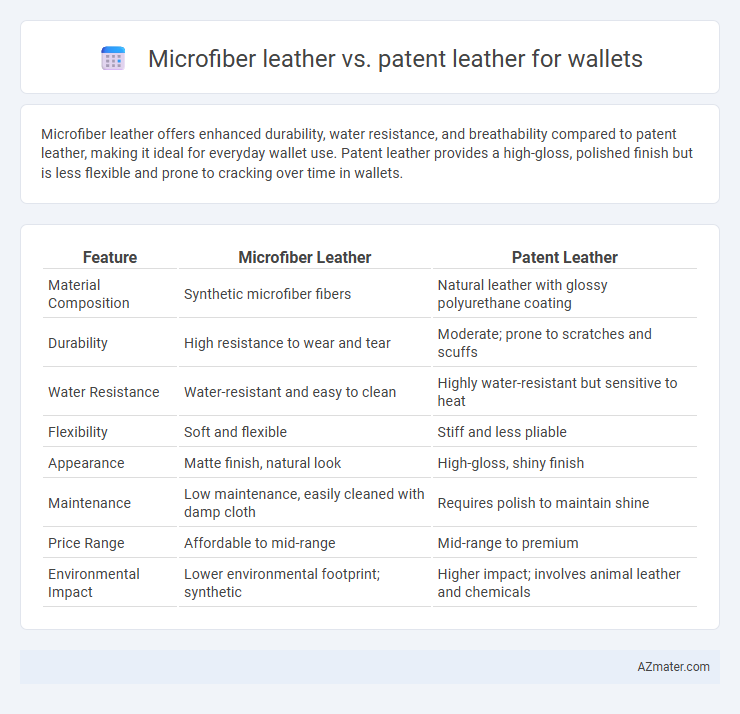Microfiber leather offers enhanced durability, water resistance, and breathability compared to patent leather, making it ideal for everyday wallet use. Patent leather provides a high-gloss, polished finish but is less flexible and prone to cracking over time in wallets.
Table of Comparison
| Feature | Microfiber Leather | Patent Leather |
|---|---|---|
| Material Composition | Synthetic microfiber fibers | Natural leather with glossy polyurethane coating |
| Durability | High resistance to wear and tear | Moderate; prone to scratches and scuffs |
| Water Resistance | Water-resistant and easy to clean | Highly water-resistant but sensitive to heat |
| Flexibility | Soft and flexible | Stiff and less pliable |
| Appearance | Matte finish, natural look | High-gloss, shiny finish |
| Maintenance | Low maintenance, easily cleaned with damp cloth | Requires polish to maintain shine |
| Price Range | Affordable to mid-range | Mid-range to premium |
| Environmental Impact | Lower environmental footprint; synthetic | Higher impact; involves animal leather and chemicals |
Introduction to Microfiber Leather and Patent Leather
Microfiber leather, crafted from ultra-fine synthetic fibers, offers high durability, breathability, and water resistance, making it an eco-friendly alternative to traditional leather. Patent leather is a natural leather coated with a high-gloss, shiny finish that enhances its visual appeal but requires careful maintenance to prevent cracking or discoloration. For wallets, microfiber leather excels in flexibility and low upkeep, while patent leather is prized for its luxurious, polished look.
Material Composition: Microfiber vs Patent Leather
Microfiber leather, composed of a polyester or nylon base coated with a polyurethane layer, offers high durability, breathability, and resistance to water and stains, making it a practical choice for wallets. Patent leather, made by applying a lacquer finish over genuine leather, provides a glossy, smooth surface but is more susceptible to scratches and requires careful maintenance. The synthetic composition of microfiber leather allows for greater flexibility and eco-friendliness, while patent leather emphasizes a classic, polished aesthetic with natural leather fibers.
Durability and Longevity Comparison
Microfiber leather offers superior durability due to its resistance to scratches, stains, and moisture, making it an ideal choice for wallets subjected to daily wear and tear. Patent leather, while visually glossy and stylish, tends to be less durable as it is prone to cracking and scuffing over time, especially without proper care. For long-lasting wallet performance, microfiber leather's synthetic composition ensures consistent strength and longevity compared to the delicate nature of patent leather.
Aesthetic Appeal and Visual Differences
Microfiber leather offers a matte or slightly textured finish that mimics genuine leather's natural grain, providing a sophisticated and understated aesthetic ideal for modern wallets. Patent leather is characterized by its glossy, high-shine surface achieved through a lacquered coating, creating a bold and eye-catching look that stands out in formal or fashion-forward designs. The visual difference lies in microfiber leather's subtle elegance versus patent leather's reflective brilliance, influencing wallet style choices based on preference for muted versus striking finishes.
Water Resistance and Maintenance Needs
Microfiber leather offers superior water resistance compared to patent leather, making it an ideal choice for wallets exposed to moisture or accidental spills. The maintenance of microfiber leather is minimal since it resists stains and can be cleaned easily with a damp cloth, unlike patent leather, which requires regular polishing to preserve its glossy finish and is prone to water spots and scratches. Choosing microfiber leather reduces the need for frequent upkeep while ensuring longevity and durability in daily use.
Environmental Impact and Sustainability
Microfiber leather offers a more sustainable alternative to patent leather for wallets due to its lower environmental footprint and reduced reliance on animal hides, significantly decreasing water usage and greenhouse gas emissions. Made from synthetic fibers, microfiber leather is often designed for durability and recyclability, while patent leather involves heavy chemical processing and finishes that can harm ecosystems. Choosing microfiber leather supports eco-friendly production practices and aligns with growing consumer demand for cruelty-free and sustainable fashion accessories.
Cost Differences: Microfiber vs Patent Leather Wallets
Microfiber leather wallets typically cost 30-50% less than patent leather wallets due to lower production expenses and raw material costs. Patent leather requires a complex finishing process involving multiple layers of lacquer, significantly increasing manufacturing costs and retail prices. Consumers seeking budget-friendly luxury often prefer microfiber leather for its affordability combined with a similar glossy appearance.
Comfort and User Experience
Microfiber leather offers superior breathability and flexibility, enhancing wallet comfort during prolonged use by adapting to hand movements and reducing sweat buildup. Patent leather, while visually striking with its glossy finish, tends to be stiffer and less breathable, potentially causing discomfort with extended handling. Users seeking a wallet with a soft, comfortable feel and durable performance often prefer microfiber leather for its lightweight and user-friendly characteristics.
Popular Uses and Market Trends
Microfiber leather offers durability and water resistance, making it popular for everyday wallets focused on longevity and ease of maintenance. Patent leather wallets are favored in luxury markets for their glossy finish and sophisticated appearance, often used in high-end fashion accessories. Recent market trends show increased demand for sustainable and vegan-friendly microfiber leather, driving innovation and growing preference among eco-conscious consumers.
Choosing the Best Leather for Your Wallet
Microfiber leather offers durability, water resistance, and a soft touch, making it an excellent choice for long-lasting wallets. Patent leather provides a glossy, polished finish but can be more prone to scratches and requires careful maintenance to retain its shine. When choosing the best leather for your wallet, consider microfiber leather for everyday wear and resilience, while patent leather suits stylish, formal occasions.

Infographic: Microfiber leather vs Patent leather for Wallet
 azmater.com
azmater.com